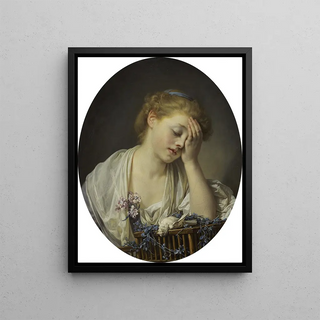Art print | A girl with a dead canary - Jean-Baptiste Greuze


View from behind

Frame (optional)
The artwork "A Girl with a Dead Canary" by Jean-Baptiste Greuze is a masterpiece that transcends mere portraiture to capture the very essence of life's fragility. Painted in the 18th century, this canvas evokes a poignant melancholy, where the delicacy of a young girl blends with the sadness of loss. The young woman, with a contemplative gaze, holds a dead canary in her hands, symbolizing ephemeral beauty and the pain of separation. This painting, far more than a simple depiction, invites reflection on human nature, vulnerability, and the emotions that dwell within us. Through this piece, Greuze manages to establish an intimate connection between the viewer and the subject, making the artistic experience deeply immersive.
Style and uniqueness of the work
Greuze's style is distinguished by meticulous attention to detail and masterful use of light. In "A Girl with a Dead Canary," the softness of the girl's features is accentuated by delicate nuances, creating an atmosphere that is both tender and tragic. The color palette, dominated by pastel tones, contributes to the sense of calm emanating from the canvas, while highlighting the contrast between youthful vitality and the morbidity of the bird. The artist excels in capturing emotions, and the girl's face, imbued with melancholy, tells a story of loss and nostalgia. This painting perfectly illustrates Greuze's ability to transform everyday scenes into profound reflections on the human condition, making each work an exploration of universal feelings.
The artist and his influence
Jean-Baptiste Greuze, an emblematic figure of the 18th-century artistic movement, is often regarded as a precursor to Romanticism. His innovative approach to genre painting, blending realism and idealization, left an indelible mark on his contemporaries and future generations. Greuze mastered capturing the subtleties of human emotions, influencing artists such as Jean-Auguste-Dominique Ingres and Eugène Delacroix. His commitment to faithfully representing feelings and expressions paved the way for a new way of understanding art.

Matte finish

View from behind

Frame (optional)
The artwork "A Girl with a Dead Canary" by Jean-Baptiste Greuze is a masterpiece that transcends mere portraiture to capture the very essence of life's fragility. Painted in the 18th century, this canvas evokes a poignant melancholy, where the delicacy of a young girl blends with the sadness of loss. The young woman, with a contemplative gaze, holds a dead canary in her hands, symbolizing ephemeral beauty and the pain of separation. This painting, far more than a simple depiction, invites reflection on human nature, vulnerability, and the emotions that dwell within us. Through this piece, Greuze manages to establish an intimate connection between the viewer and the subject, making the artistic experience deeply immersive.
Style and uniqueness of the work
Greuze's style is distinguished by meticulous attention to detail and masterful use of light. In "A Girl with a Dead Canary," the softness of the girl's features is accentuated by delicate nuances, creating an atmosphere that is both tender and tragic. The color palette, dominated by pastel tones, contributes to the sense of calm emanating from the canvas, while highlighting the contrast between youthful vitality and the morbidity of the bird. The artist excels in capturing emotions, and the girl's face, imbued with melancholy, tells a story of loss and nostalgia. This painting perfectly illustrates Greuze's ability to transform everyday scenes into profound reflections on the human condition, making each work an exploration of universal feelings.
The artist and his influence
Jean-Baptiste Greuze, an emblematic figure of the 18th-century artistic movement, is often regarded as a precursor to Romanticism. His innovative approach to genre painting, blending realism and idealization, left an indelible mark on his contemporaries and future generations. Greuze mastered capturing the subtleties of human emotions, influencing artists such as Jean-Auguste-Dominique Ingres and Eugène Delacroix. His commitment to faithfully representing feelings and expressions paved the way for a new way of understanding art.






